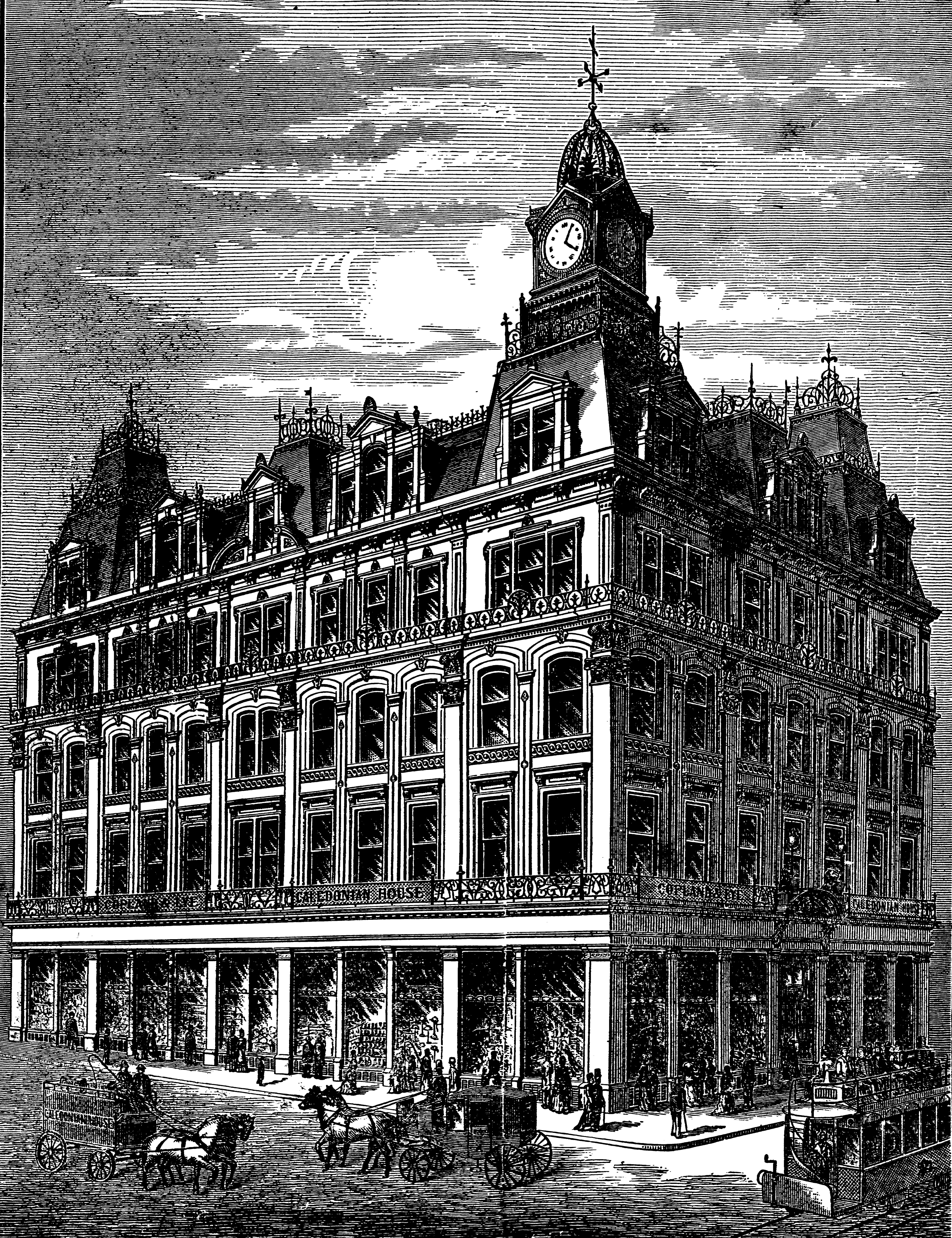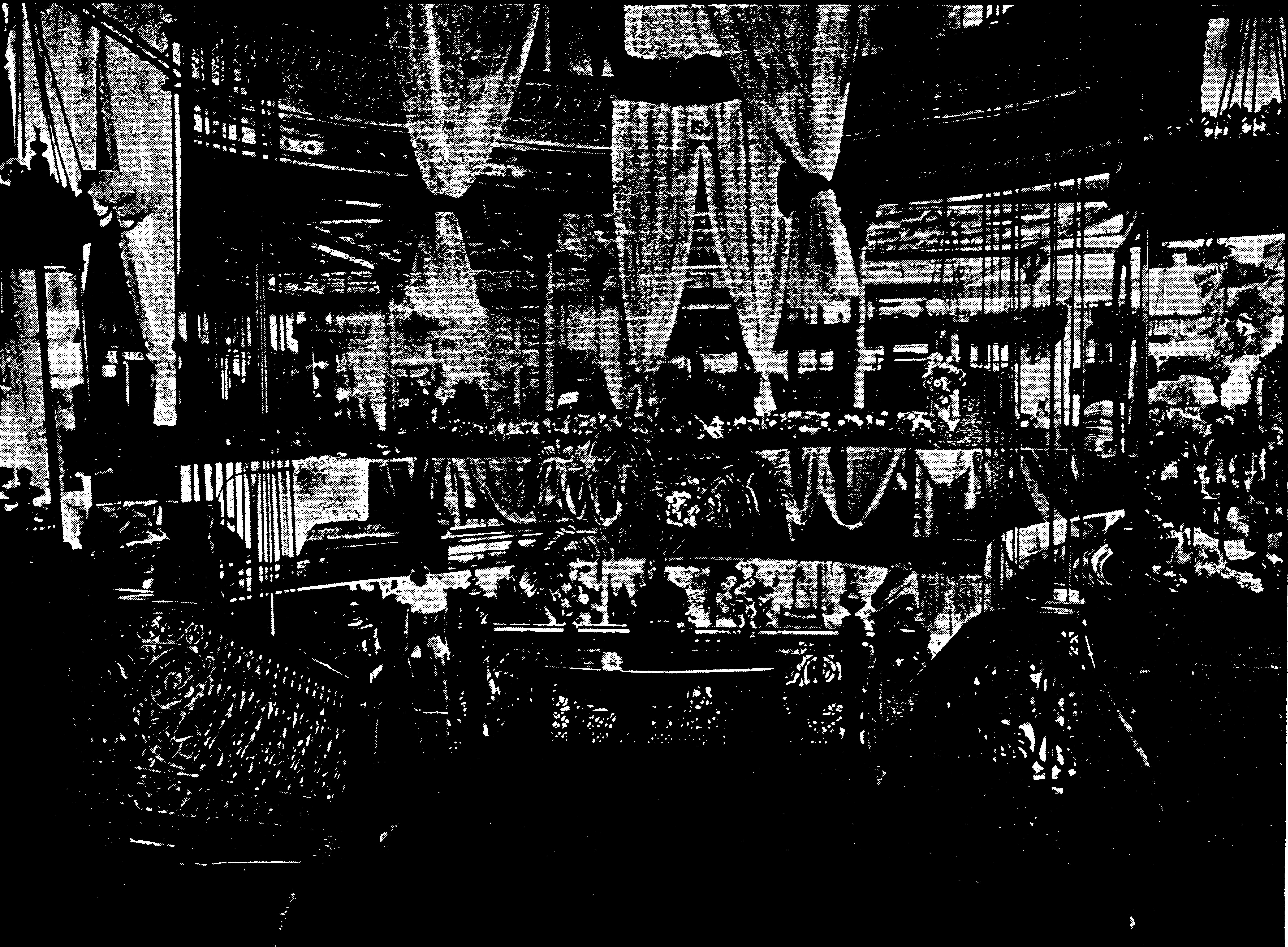 Copland and Lye
Copland and Lye
 Copland and Lye
Copland and Lye
COPLAND AND LYE, Warehousemen, 165, 167 & 179 Sauchiehall Street, Glasgow.
Probably in no part of Her Majesty's vast dominions - not even excepting the metropolis itself - has such steady progress been made in the exemplification of the highest developments attainable in connection with the drapery trade as in Glasgow, and prominent among the great city concerns which have lustre to their profession and distinct advantage to themselves by their enterprising methods of business, must be named the well-known firm of Messrs. Copland and Lye, whose magnificent emporium in Sauchiehall Street unquestionably forms one of the lions of the city, and an unending source of delight to brilliant assemblages of the fair sex, who frequent the establishment in the knowledge that therein will be found the fullest representation of the latest fashions in every description of ladies and childrens attire, gentlemens outfits, and household draperies and furniture, suited to the embellishment either of the princely palace or of the artisans tastefully-appointed cottage.
The history of the firm dates from the year 1873, when it was founded by Mr. William Copland and Mr. John Lye. The primary operations of the firm were conducted in Cowcaddens, about twenty assistants being employed. Within five years from the date of its inception, the concern had developed to such massive proportions that increased accommodation became absolutely necessary, and the firm entered into the premises known as Caledonian House, one of the most extensive, most architecturally elegant, and most perfectly equipped drapery emporiums to be met with in the kingdom. Up to the present hour the firm has steadily developed the field of its operations, and kept pace with the growing demands of a critical drapery trade. A record such as that possessed by this firm is creditable alike to its executive and to the community wherein such achievements are possible. The success of the house may in great part be ascribed to the fertility of resource, the zealous care, and the originality of method displayed in carrying out the schemes which have resulted so favourably. Some idea of the vast development in the firms business may be formed from the fact that instead of the twenty assistants who sufficed at the outset to meet all the exigencies of the concern, no fewer than four hundred employees are engaged, involving an annual expenditure of fifteen thousand pounds sterling.
In November, 1884, Mr. Wm. Copland died, and within the past three, both Mr. John Lye and also one of his sons have been removed by the hand of death. The personnel of the firm at the present time consists of Mr. John Lye, son of the founder, and Mr. Robert A. Ogg, a gentleman who for many years held the senior partnership in the well-known house of Messrs. Ogg and Hodge, at Anderston, Glasgow.
The most recent step of importance in the annals of the business has been the remodelling of a portion of the premises. The frontage has been greatly extended, all the windows enlarged, and a perfectly organised system of ventilation established throughout the entire premises. While the exterior of Messrs. Copland and Lyes establishment is one of the finest in Glasgow, the interior is no less imposing, as a cursory inspection will show.
 On entering the ground floor one is impressed with the
elegant appointments of the lofty, well-lighted apartments. Here hosiery and
gloves, haberdashery, calicoes, linens, muslins, damasks, sheetings, flannels,
long-cloths, and every class that comes within the categoryr Manchester goods,
stand in striking contrast with the ornamental gimps, braids, and edgings, which
constitute the staple of the trimming department. Nor can the lace and ribbon
depaitments escape notice. Here can be procured every make of lace in the
choicest designs. In the silk department may be inspected all the latest
novelties in black and coloured silks, satins, plushes, velvets, and velveteens,
whilst less expensive fabrics include crepes, chintzes cashmeres, merinoes, and
tweeds. There is also a department devoted to ladies and childrens
underclothing, in which an endless choice is afforded the purchaser. The
magnificently appointed showrooms assigned to millinery, mantles, and costumes,
are replete with a stock unsurpassed throughout the kingdom in respect of
novelty of design and excellence of workmanship and material.
On entering the ground floor one is impressed with the
elegant appointments of the lofty, well-lighted apartments. Here hosiery and
gloves, haberdashery, calicoes, linens, muslins, damasks, sheetings, flannels,
long-cloths, and every class that comes within the categoryr Manchester goods,
stand in striking contrast with the ornamental gimps, braids, and edgings, which
constitute the staple of the trimming department. Nor can the lace and ribbon
depaitments escape notice. Here can be procured every make of lace in the
choicest designs. In the silk department may be inspected all the latest
novelties in black and coloured silks, satins, plushes, velvets, and velveteens,
whilst less expensive fabrics include crepes, chintzes cashmeres, merinoes, and
tweeds. There is also a department devoted to ladies and childrens
underclothing, in which an endless choice is afforded the purchaser. The
magnificently appointed showrooms assigned to millinery, mantles, and costumes,
are replete with a stock unsurpassed throughout the kingdom in respect of
novelty of design and excellence of workmanship and material.
The firm, too, makes a specialty of its mourning department. To drapery houses of medium resources, no branch of the business is more embarrassing than this ; but the imperative necessities imposed by family bereavement are catered for by Messrs. Copland and Lye with a certainty and expedition beyond all praise. Grateful and quite unsolicited testimony is quite frequently tendered to the proprietors for services rendered by them in emergencies such as we have referred to, and it is not surprising that in the mourning and funeral undertaking departments of their business there is constantly taking place a widely diffused augmentation. Throughout this splendidly organised establishment there is one prevailing characteristic, namely, plentitude of commercial resource and perfect freedom from the not unusual embarrassments experienced on emergencies, even by the largest industrial enterprises.
 To anticipate the wants of patrons has been at once the
prime object of the proprietary and the secret of its success. Messrs. Copland
and Lye have not pursued a temporary gain at the expense of a permanent
reputation, but, on the contrary, have studied their own best interests by first
studying the interests of their patrons. In closing this review, we may say that
the almost phenomenal success of this great concern, a success that has attended
its career from its very inception, is due in a large measure to a splendid
efficiency of management. Buyers, sellers, foremen of departments, and
assistants, down to the humblest dressmaker, milliner, or counter-hand,, all are
alike in the possession of an individual capacity, and, from the heads of this
great organisation, all through the ranks of the executive staff, and down to
the humblest employee, the spirit of thorough courtesy and competency is
all-prevalent, and the will and the power to serve, promote, and sustain the
interests of the firm and its host of indirect supporters in the great mass of
the public, are everywhere manifest and predominant. Where such a condition of
affairs exists, it may be taken for granted that there will be, as in the case
before us, a full accomplishment of those high commercial aims and purposes
which invariably spell prosperity, and which secure for those who administer a
lasting niche in the Temple of Industrial Fame, none the less sweet and
enviable because it is the consummation of earnest hope and long continued
endeavour.
To anticipate the wants of patrons has been at once the
prime object of the proprietary and the secret of its success. Messrs. Copland
and Lye have not pursued a temporary gain at the expense of a permanent
reputation, but, on the contrary, have studied their own best interests by first
studying the interests of their patrons. In closing this review, we may say that
the almost phenomenal success of this great concern, a success that has attended
its career from its very inception, is due in a large measure to a splendid
efficiency of management. Buyers, sellers, foremen of departments, and
assistants, down to the humblest dressmaker, milliner, or counter-hand,, all are
alike in the possession of an individual capacity, and, from the heads of this
great organisation, all through the ranks of the executive staff, and down to
the humblest employee, the spirit of thorough courtesy and competency is
all-prevalent, and the will and the power to serve, promote, and sustain the
interests of the firm and its host of indirect supporters in the great mass of
the public, are everywhere manifest and predominant. Where such a condition of
affairs exists, it may be taken for granted that there will be, as in the case
before us, a full accomplishment of those high commercial aims and purposes
which invariably spell prosperity, and which secure for those who administer a
lasting niche in the Temple of Industrial Fame, none the less sweet and
enviable because it is the consummation of earnest hope and long continued
endeavour.
Back to Index of Firms (1891)